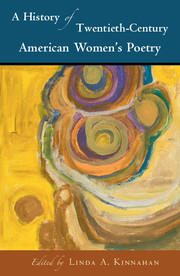Book contents
- Frontmatter
- Contents
- List of figures
- List of contributors
- Preface
- Acknowledgments
- PART I MAPPINGS AND CHRONOLOGIES
- PART II ETHNICITY, RACE, AND IDENTITY
- PART III MATERIAL FORMATIONS
- PART IV LINEAGES, TIES, AND CONNECTIONS
- 15 Token Women, Male Movements, and Literary History's Feminist Shadow
- 16 Lineages and Legacies: Real and Imagined
- 17 Crossing Geographies, Crossing Languages
- 18 Women's “spiritualities”
- PART V FORM, LANGUAGE, AND TEXT
- PART VI CODA
- Bibliography
- Index
16 - Lineages and Legacies: Real and Imagined
from PART IV - LINEAGES, TIES, AND CONNECTIONS
Published online by Cambridge University Press: 05 June 2016
- Frontmatter
- Contents
- List of figures
- List of contributors
- Preface
- Acknowledgments
- PART I MAPPINGS AND CHRONOLOGIES
- PART II ETHNICITY, RACE, AND IDENTITY
- PART III MATERIAL FORMATIONS
- PART IV LINEAGES, TIES, AND CONNECTIONS
- 15 Token Women, Male Movements, and Literary History's Feminist Shadow
- 16 Lineages and Legacies: Real and Imagined
- 17 Crossing Geographies, Crossing Languages
- 18 Women's “spiritualities”
- PART V FORM, LANGUAGE, AND TEXT
- PART VI CODA
- Bibliography
- Index
Summary
Taking us by and large, we're a queer lot
We women who write poetry. And when you think
How few of us there've been, it's queerer still.
Amy Lowell, “The Sisters”When Amy Lowell published “The Sisters” in 1922, her willingness to position herself as part of a sisterhood of poets was, in many ways, a radical act. Coming in the wake of movements such as Futurism and Vorticism, which fetishized a particular vision of masculine power and genius, Lowell's poem singles out three women, Sappho, Elizabeth Barrett Browning, and Emily Dickinson, each of whom offer a vision of the life of a woman poet to the speaker. Ultimately, Lowell's speaker finds these “older sisters” “sobering things,” “[f]rightfully near, and rather terrifying,” and realizes that her approach to being a woman poet “[w]ill not be any one of yours” (75). Nevertheless, she ultimately claims herself and them as members of “one family,” “great” and “marvellously strange” (75). Of course, even as Lowell's poem celebrates one kind of affiliative tradition, the very next year she engaged in a kind of de-affiliation in an essay published in the New Republic's special issue on American poetry titled “Two Generations in American Poetry.” In that essay, Lowell cautions against a “second generation” of modern poets who are “all feminine,” too concerned with “the perennial theme of love” and insufficiently rigorous in “intellectual content.” Reading Lowell's essay alongside “The Sisters,” we see a particular structure of literary history come into focus, one that selects out a small group of women as forebears while deliberately – if silently – consigning myriad women poets to obscurity. In making her sisterhood and generational models, Lowell selected out a tiny group of women and ignored the vast majority of the rest, past and present.
Jump ahead to 1983, when a group of women got together to found the newsletter HOW(ever) as a venue where experimental women writers could be in touch with women academics working to recover a tradition of women's experimentalism. These poets and scholars were troubled by the lack of available materials on modernists like Gertrude Stein, H.D., Marianne Moore, and others, writers whose presence irrefutably shaped early twentieth-century poetics but whose legacies were in danger of being lost.
- Type
- Chapter
- Information
- A History of Twentieth-Century American Women's Poetry , pp. 258 - 273Publisher: Cambridge University PressPrint publication year: 2016

